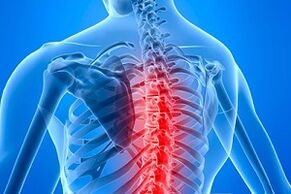Osteochondrosis is a pathology caused by degenerative processes of cartilage tissue.In most cases, the stable functioning of the intervertebral discs is observed, therefore they are most often referred to as osteochondrosis of the spine.
Pathogenesis
First of all, osteochondrosis is associated with the fact that a person is in a vertical position for a long time, which causes an increased load on the spine and intervertebral discs.
As age progresses, the functionality of blood vessels decreases, the diet becomes more balanced, the body ages, which only accelerates the development of pathological processes.

Osteochondrosis is a multifactorial disease;the main prerequisites for its development may be:
- work involving vibration or in which the position of the body changes frequently (bending-extending, turning, bending, jerking movements);
- weight-lifting;
- overweight;
- multiple pregnancy;
- lack of vitamins in the body;
- sedentary lifestyle;
- sleep on a soft mattress;
- bad posture (scoliosis);
- vertebral instability.
Exacerbation of the dystrophic process of disc destruction may be associated with intense physical activity (especially without prior warm-up), injuries or skeletal pathology that changes the load distribution of the spinal column.
Typical signs of pathology
Numbness and pain, as the main manifestation of osteochondrosis, can be observed in the whole body or only in the back.The pain is aggravated by sudden movement, physical activity, sometimes sneezing or coughing.The body's attempt to protect itself from pain leads to increased muscle tension and limited motor skills.
If the person is not given help and treatment is not started, the pain will get worse, spread to the limbs and limit the ability to move.When the cervical thoracic spine is affected, the arms are affected, and the lower limbs are affected when the lumbar spine is affected.
Symptoms vary depending on which part of the spine is affected.
Types and symptoms of osteochondrosis
The pathology can affect different parts of the spine.Taking into account the localization, osteochondrosis can develop in the cervical (more than 25% of diagnosed cases), lumbar (more than 50%) or thoracic (12%) regions.
Exacerbation of the dystrophic process of disc destruction may be associated with intense physical activity (especially without prior warm-up), injuries or skeletal pathology that changes the load distribution of the spinal column.
Osteochondrosis of the neck
The spinal cord, arteries (supplying the brain), nerve trunks and roots (making nerve connections to the arms, lungs, and heart) pass through the neck region.As the years go by, especially for those who are untrained or spend long periods of time working on a computer, the movement of the neck becomes difficult.
Symptoms characteristic of cervical osteochondrosis:
- headache and heartache;
- dizziness (possible short-term loss of consciousness associated with disruption of blood supply to the brain);
- numbness and pain in the shoulder joints or arms.
Osteochondrosis of the thoracic region

Chest pain is familiar to those who often and for a long time perform physical work, representatives of "sedentary" professions (architects, designers, drivers).
The main symptoms of osteochondrosis of the chest region:
- a feeling of "stake in the chest";
- painful sensations in the neck region, between the shoulder blades;
- numbness of the hands (temporary, long-term);
- hearing and vision impairment;
- increased sweating;
- headache radiating to the back of the head (often lasting up to 12 hours);
- changes in blood and intracranial pressure;
- tachycardia and arrhythmia.
A good prevention of thoracic osteochondrosis is correct posture.
Symptoms of lumbar osteochondrosis
Health problems caused by osteochondrosis in the lumbar region include:
- frequent urination;
- numbness of the limbs;
- dizziness;
- muscle cramps and spasms;
- movement difficulties, bending and turning of the body;
- development of scoliosis;
- lower back pain, especially in the morning, right after waking up;
- impaired muscle sensitivity and tone.
The pain and its intensity reach their peak in the acute period of the disease.Their duration can bother a person for several days, but sometimes the pain lasts for weeks or even months.As the pathological process occurring in the intervertebral discs progresses, the severity of the symptoms decreases.After 60 years, the disease becomes chronic, the pain disappears.
Stages of the disease
Osteochondrosis is a progressive pathology, the transition to all other forms occurs gradually.One stage of this is the formation of a hernia, which occurs when the fibrous ring thins.As a result of the tear, the nucleus protrudes and the roots are compressed, which leads to increased pain and a decrease in the disc's ability to absorb shock.
The main stages of the development of osteochondrosis:
- A person develops characteristic complaints caused by physical exertion or prolonged stay in one position.The X-ray shows a slight narrowing of the spaces between the vertebrae.
- Loss of disc stability, cartilage tissue extends into the annulus fibrosus, and nerve roots are compressed.The X-ray shows the reduction of the distance between the vertebrae, the displacement of the vertebrae and the proliferation of bone tissue.
- Intervertebral hernias develop.The disc penetrates more and more into the surrounding tissues.Its violation causes damage to nerves and blood vessels.The pain increases, numbness and limited movement of the limbs occur.
- The disc hardens and is replaced by scar tissue.In the case of fibrosis, bony protrusions grow at the edges, and the distance between the vertebrae decreases significantly.The mobility of the spine decreases, it seems to ossify.
Diagnosis of osteochondrosis
The doctor makes the preliminary diagnosis based on the patient's complaints and after a visual examination.Pain and tenderness at each point, muscle tone, range of motion, and postural abnormalities (such as scoliosis) are taken into account.
The presence and stage of osteochondrosis are clarified after conducting instrumental research methods.First of all, an X-ray of the part of the spinal column of interest is prescribed.
After studying the images, the specialist determines:
- has the intervertebral distance decreased;
- whether the cartilage tissue is depleted;
- what stage is the ongoing pathological process.
If an intervertebral hernia is detected in a patient, an MRI is prescribed.By scanning and visualizing the soft tissues layer by layer, the preliminary diagnosis can be confirmed or refuted with high accuracy.
How to treat osteochondrosis
The therapy of the disease is long-term, the main goal is to relieve pain and muscle tension, as well as to stop the development of the pathological process after identifying the provoking cause.
The specialist decides which treatment method will be the most effective, based on the results of the examination and the severity of the ongoing pathology.process.
Drug treatment of osteochondrosis

The main goal of this type of disease is to stop the inflammatory process and pain, as well as relieve muscle spasm.This can be done by admitting the patient:
- Nonsteroidal anti-inflammatory drugs.In order to reduce the tone of skeletal muscles, muscle spasms and compression of nerve roots, the specialist supplements NSAID drugs with muscle relaxants.
- Group B vitamin preparations.
The optimal treatment period is 7-10 days.
Drug treatment is often supplemented with local treatment.Warming ointments or gels containing NSAIDs can be applied to the affected area, which helps to increase blood supply, metabolism, and stop inflammation.External remedies quickly relieve pain, as the main active ingredient penetrates the inflammation and begins to "act" immediately.
Medication is usually supplemented with exercise therapy, massage, physio-reflexology or manual therapy.
The main task of people suffering from osteochondrosis is to reduce the frequency and severity of pain symptoms (especially during exacerbation).Compliance with the doctor's recommendations and the combined use of drugs with physical therapy exercises will help restore the normal function of the spine and avoid surgical intervention.
















































